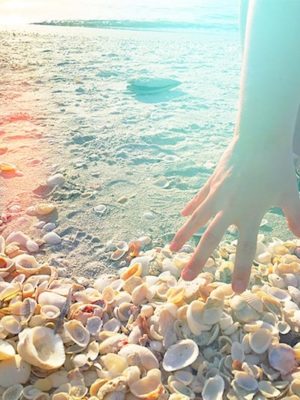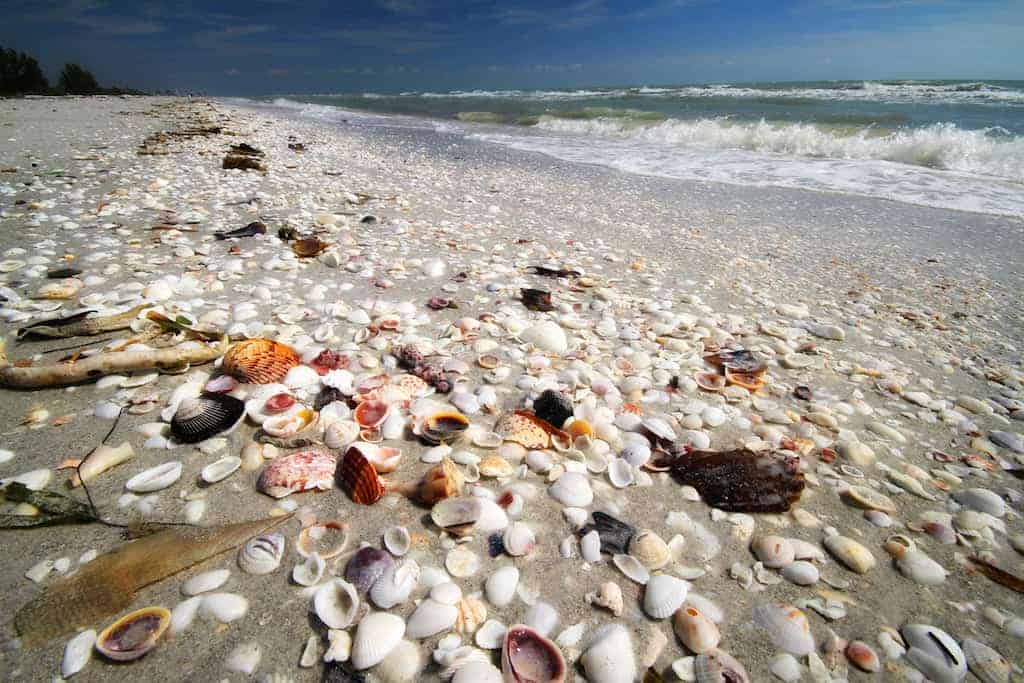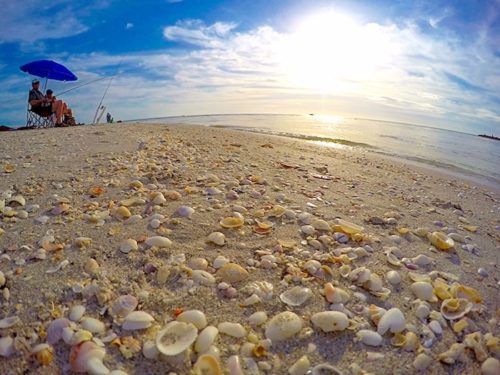Sanibel Island is located on the West Coast of Florida. Not far from Captiva, Fort Myers, Naples, and Marco Island. Any of these destinations can work as tropical vacation spots, but Sanibel has something unique: some of the best “shelling” in the world.
We spent some time on the island tasting wine, pairing it with local seafood, fishing, diving and collecting beautiful shells.
While a multitude of mollusk species can be found and collected all around Sanibel and Captiva, today we’re going to focus on a couple of beaches and restaurants located on the Northwestern side of Sanibel.
These two beaches, known as Bowman’s Beach and Blind Pass Beach, offer shell collectors a unique opportunity to enhance their collections.
Note that while shell hunting on Sanibel is permitted to anyone who would like to partake, collection of any live species is strictly prohibited. I’ll go into why that is a little further on in this post. In the meantime, let’s briefly discuss best practices for shell hunting on these beaches, and also touch on what we believe to be the best shells to look for at these locations.
RELATED: Florida Gulf Coast Travel Guide: The Perfect Road Trip Itinerary
Tips for Sanibel Island Shelling
Timing is Everything for Shell Collecting on Sanibel
Low tide is your best bet for finding shells anywhere on Sanibel Island. Regardless of what beach you decide to visit, more beach area opens up at lower tides. Low tide also exposes more shells that may have washed in with the fast currents in the area.
During both the late autumn season as well as throughout winter, tides on Sanibel are more extreme, thus bringing in and exposing more shells. The more dramatic a low tide is, the better. Make sure you research when low tide will occur before visiting Sanibel for the best experience.
The best time to collect shells on Sanibel is 1 1/2 hours before and after low tide. The best days for shell hunting fall on full moons and new moons.
Shell hunting after a storm is also ideal. If you’re lucky enough to visit Sanibel the day after a storm hits and it’s sunny out, it won’t get much better. Storms stir up the ocean, thus pushing more expired sea life on and along the shorelines.
Aside from low tide and stormy weather, one other factor that may shape the timing of your visit is traffic. While it’s a popular destination year-round, once the autumn season sets in, more crowds tend to arrive as temperatures begin to cool off. It’s also a good time to get the best low tides. If you’re feeling brave, go shell collecting at night just after the tide turns. Bring a flashlight with you and enjoy the sound of the waves without the tourists.
The Spring season in Sanibel also brings tourists, though the tides aren’t as good. If you’re planning on visiting Sanibel Island, the season should play a big part. At the same time, so should the time of day. If you can time it right, see if you can get a low tide towards late afternoon. At this point, many tourists will have retired from the beach, thus leaving more parking AND more shells on the exposed flats.
You May Need to Get Wet
Sanibel Island is becoming increasingly well known as not only a shell hunter’s paradise, but also as a beautiful place to soak up the sun. The influx of tourists in recent years means that many of the accessible shells laying on the shore will likely have already been picked over.
If you can’t time low tide appropriately, you might consider snorkeling along the shoreline and grabbing the shells still underwater. Keep in mind that this is easier to do on Bowman’s Beach, because the rip tide is less intense. Swimming is actually not recommended at Blind Pass.
If you bring a snorkel and mask, you don’t need to go that far offshore to start finding beautiful sea shells. We ventured no more than 10 yards offshore and found numerous beautiful Florida fighting conchs and lightning whelks. Typically there is a sandy ledge that resides only a few yards off the beach. Shells tend to collect here so keep an eye out or scoop a net or shovel through the piles along the ledge.
Also, keep in mind that the water clarity off of Sanibel is not the best in the world. You won’t be able to float on the surface and spot shells. You’ll need to dive down. As long as you’re comfortable sticking your face near the sandy bottom, you’re sure to come up with some beauties.
Park Smart
With regard to parking at Bowman’s Beach, you can expect to find a fair amount of space near the beach entrance during most seasons. This depends on the time of day, but we have never had any problem parking alongside Bowman’s. Also note that if you opt for visiting Bowman’s Beach, the trek from the parking lot is around 1 quarter of a mile. Keep this in mind if you’re moving a lot of gear from the car to the beach. A cart may be necessary.
Blind Pass Beach has very limited parking, maybe 15-20 spaces. Your best bet for parking around Blind Pass is to go early in the morning or later in the afternoon.
Know Your Species
When you’re shell hunting on Sanibel Island, it’s much more efficient when you know what to look for. There are well over 60 different types of mollusks, ranging from snails to conchs, to whelks, to scallops, and even whelk eggs. Scroll down as we list out our favorite shells to find on Sanibel Island below.
Protect the Environment
It’s illegal to take or kill a live mollusk on any of the beaches around Sanibel Island. That’s because these unique sea creatures are responsible for keeping the water quality in the region so great. These shells, which were once live animals, filter out the water and help to filter out toxins and microorganisms that are detrimental to the environment. The more live mollusks there are in the area, the healthier Sanibel’s beaches will be. Overtime, more mollusks will survive to repopulate the area. Many of the most popular mollusks around Sanibel and Captiva only live 3 years. Scallops are one species in particular with a short lifespan. Certain species of conch and whelk can live between 10 and 20 years. Once their natural life cycle has expired, their ‘homes’ (shells) are free for the taking!
Where To Stay on Sanibel
Sanibel isn’t a very large island. Thus, your hotel options will be somewhat limited. You should expect quaint bungalows, townhouses, and small beachside properties rather than full-on luxury resorts. That being said, it’s actually an extremely relaxing change of pace. The majority of hotel properties on Sanibel are 3 stars or lower, but they’re perfect for the location. Here are a couple of our favorites:
Arguably the most luxurious property on the island, this beautiful location is one of only a couple on the far Northwestern side. It’s over 330 oceanfront acres, with its own 2.5-mile-long white-sand beach. Ideal for a honeymoon or romantic weekend getaway. You can get large, bright rooms with ocean views, to multi-room cottages and villas that come with free WiFi and many with balconies (be sure to request one).
If you get tired of shelling, there are 6 places to eat and taste wine across the property, a spa, and also 2 golf courses.
A semi-luxury and 3-Star property on the island, this more upscale hotel offers a central location to see the island and navigate by car. The hotel was built back in 1895, but has obviously been refurbished and nicely updated to have a fresh, clean island feel. It’s also on a private beach that offers its own opportunity to find nice shells just offshore. It’s also only 6 miles from Bowman’s Beach.
Balconies are screened, which offers nice protection in the late afternoon hours from any mosquitos. There’s free WiFi and full kitchens in the suites, and quaint cottages that range from 1 to 3 bedrooms.
Where To Taste Wine and Eat
There are two restaurants we recommend for tasting wine and specifically pairing it with food on the island. Note that there are many other great places to eat on the island, these two just happen to have some of the best wine lists and are a bit more up-scale. Ideal for pairing unique dishes with special wines.
Bleu Rendez-Vous French Bistro
This upscale French restaurant is not only beautiful, the service is likely the best on the island. The food is exquisite and crafted with the utmost care. From 1st Cru Burgundy Chablis, Loire Valley and Alsace whites, ideal for pairing with fish and shellfish, to delicious Rhone reds and Bordeaux blends from excellent vintages. The Bleu Rendez-Vous knows their French wine, and they know how to pair it. You can’t miss here, but be prepared to spend a little bit of money.
The Sandbar
This fun, beachy, yet up-scale seafood restaurant conviently dubbed “The Sandbar” gets you a bit off the beaten path to try some local seafood and pair it with excellent white wine (I usually stick with the New Zealand New Harbor Sauvignon Blanc). It can get crowded, so try and call ahead for a reservation. Regardless, you can usually show up and be seated even when it’s loaded.
Gear You May Need
Any discerning shell hunter should bring a few essential items to the beach in order better their chances and make collecting easier. These items include, but are not limited to:
You may click on each item to purchase on Amazon.
- Mesh-styled collection bag (Mesh is an ideal material so water can drain as you dive for shells)
- Plastic shovel (A small shovel is good, and you want plastic so you have less of a chance of damaging shells)
- Plastic hand-held rake
- Plastic Sand Scoop + 2 in 1 Sieve
(This is a great affordable piece that combines a sieve and shovel in one)
- Metallic sieve (For sand filtration)
- Bottle container for small shells
- Bucket or bag for large shells
- Water bottle
- Suntan lotion
- Organic bug spray (essential at Blind Pass Beach especially around Sunset)
- Waterproof Notebook
- Waterproof pen
- Camelbak Backpack
Cleaning and Moving Your New Shell Collection
Ever wonder how serious shell collectors get their shells to look so pristine? They treat them with a special formula of TLC. Keep in mind, however, that not all shells should be bleached. Depending on what you aim to do with your shells, there are a number of ways you can go about taking care of them.
- When you first get back home or to your hotel, rinse your shells to get rid of the ‘surface level’ of debris. If there are more stubborn organics attached to your shells, pluck them off with tweezers.
- For your more classic shells that don’t have extraordinary colors or designs, like your typical white slipper snail, alternate tellin, or Florida prickly cockle, soak them in a bucket comprised of 50% water and 50% bleach overnight.
Important: If you’ve collected dead sand dollars, do not soak in the above solution longer than 30 minutes.
When you wake up the next morning, use a toothbrush or small not-too-abrasive brush to scrub your shells. If you’d like to bring out the color in your new shell collection, use mineral oil on a cotton ball to do so. Let the mineral oil soak for at least 30 minutes and then remove any excess oil with a dry cotton ball.
The Baily-Matthews National Shell Museum recommends that you use 3 coats of 50% water and 50% Elmer’s glue solution on sand dollars and sea urchins to make them stronger.
Transporting your Shells
Shell Transport Hack: Add soft sand to your collection bottle to cushion the shells
If you have the means, add cotton balls to your collection bottles and bags to protect your shells as you move them. You can actually wrap your shells with basic scotch tape and cotton balls to secure each individual shell. Just make sure you take the tape off once you’re done traveling as it could leave a residue over time after being in a hot environment. You can use a wide-mouth bottle container like this one to store your shells during transport. Or you could do some travel hacking and use an empty mayonnaise container or zip-lock bag (remember, sand and cotton balls). Paper towels, toilet paper and cushioned plastic-like bubble wrap are also good choices.
Collect Them All!
As mentioned, there are well over 60 shells present in the Sanibel and Captiva regions. If you go around grabbing every shell you see, it won’t be long before your shell collecting bag is bursting at the seams. Have fun!

